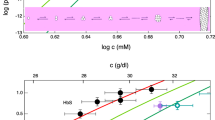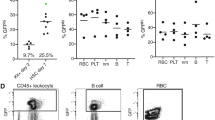Abstract
Sickle cell disease is a hereditary disorder characterized by erythrocyte deformity due to hemoglobin polymerization. We assessed in vivo the potential curative threshold of fetal hemoglobin in the SAD transgenic mouse model of sickle cell disease using mating with mice expressing the human fetal Aγ-globin gene. With increasing levels of HbF, AγSAD mice showed considerable improvement in all hematologic parameters, morphopathologic features and life span/survival. We established the direct therapeutic effect of fetal hemoglobin on sickle cell disease and demonstrated correction by increasing fetal hemoglobin to about 9–16% in this mouse model. This in vivo study emphasizes the potential of the SAD mouse models for quantitative analysis of gene therapy approaches.
This is a preview of subscription content, access via your institution
Access options
Subscribe to this journal
Receive 12 print issues and online access
$209.00 per year
only $17.42 per issue
Buy this article
- Purchase on Springer Link
- Instant access to full article PDF
Prices may be subject to local taxes which are calculated during checkout



Similar content being viewed by others
References
Bertles, J.F. & Milner, P.F. Irreversibly sickled erythrocytes: a consequence of the heterogeneous distribution of hemoglobin types in sickle-cell anemia. J. Clin. Invest. 47, 1731– 1741 (1968).
Charache, S. et al. Effect of hydroxyurea on the frequency of painful crises in sickle cell anemia. N. Engl. J. Med. 332, 1317–1322 (1995).
Dover, G.J., Brusilow, S. & Charache, S. Induction of fetal hemoglobin production in subjects with sickle cell anemia by oral sodium phenylbutyrate. Blood 84, 339–343 (1994).
McCaffrey, P.G., Newsome, D.A., Fibach, E., Yoshida, M. & Su, M.S.-S., Induction of γ-globin by histone deacetylase inhibitors. Blood 90, 2075–2083 (1997).
Perrine, S.P. et al. A short-term trial of butyrate to stimulate fetal-globin-gene expression in the β-globin disorders. N. Engl. J. Med. 328, 81–86 (1993).
Stamatoyannopoulos, G. et al. Fetal hemoglobin induction by acetate, a product of butyrate catabolism. Blood 84, 3198– 3204 (1994).
Popp, R.A. et al. A transgenic mouse model of hemoglobin S Antilles disease. Blood 89, 4204–4212 ( 1997).
Paszty, C. et al. Transgenic knockout mice with exclusively human sickle hemoglobin and sickle cell disease. Science 278, 876 –878 (1997).
Ryan, T.M., Ciavatta, D.J. & Townes, T.M. Knockout-transgenic mouse model of sickle cell disease . Science 278, 873–876 (1997).
Fabry, M.E. et al. A second generation transgenic mouse model expressing both hemoglobin S (HbS) and HbS-Antilles results in increased phenotypic severity . Blood 86, 2419–2428 (1995).
Greaves, D.R. et al. A transgenic mouse model of sickle cell disorder. Nature 343, 183–185 ( 1990).
Trudel, M. et al. Towards a transgenic mouse model of sickle cell disease: hemoglobin SAD. EMBO J. 10, 3157–3165 (1991).
De Paepe, M.E. & Trudel, M. The transgenic SAD mouse: a model of human sickle cell glomerulopathy. Kidney Int. 46, 1337–1345 ( 1994).
Blouin, M.-J., De Paepe, M. & Trudel, M. Altered hematopoiesis in murine sickle cell disease . Blood 94, 1451–1459 (1999).
Trudel, M. et al. Sickle cell disease of transgenic SAD mice. Blood 84, 3189–3197 ( 1994).
De Franceschi, L., Saadane, N., Trudel, M., Brugnara, C. & Beuzard, Y. Treatment with oral clotrimazole blocks Ca2+-activated K+transport and reverses erythrocytes dehydration in transgenic SAD mice. J. Clin. Invest. 93, 1670–1676 (1994).
Enver, T., Ebens, A.J., Forrester, W.C. & Stamatoyannopoulos, G. The human β-globin locus activation region alters the developmental fate of a human fetal globin gene in transgenic mice. Proc. Natl. Acad. Sci. USA 86, 7033–7037 ( 1989).
Stamatoyannopoulos, G., Josephson, B., Zhang, J.-W. & Li, Q. Developmental regulation of human gamma-globin genes in transgenic mice. Mol. Cell. Biol. 13, 7636–7644 (1993).
Powars, D.R., Weiss, J.N., Chan, L.S. & Schroeder, W.A. Is there a threshold level of fetal hemoglobin that ameliorates morbidity in sickle cell anemia? Blood 63, 921–926 (1984).
Serjeant, G.R. Irreversibly sickled cells and splenomegaly in sickle-cell anaemia. Br. J. Haematol. 19, 635–641 (1970).
Platt, O.S. et al. Pain in sickle cell disease: Rates and risk factors. N. Engl. J. Med. 325, 11–16 (1991).
Platt, O.S. et al. Mortality in sickle cell disease: Life expectancy and risk factors for early death. N. Engl. J. Med. 330, 1639–1644 (1994).
Noguchi, C.T., Rodgers, G.P., Serjeant, G. & Schechter, A.N. Levels of fetal hemoglobin necessary for treatment of sickle cell disease . N. Engl. J. Med. 318, 96– 99 (1988).
Croizat, H. & Nagel, R.L. Circulating BFU-E in sickle cell anemia: Relationship to percent fetal hemoglobin and BPA-like activity. Exp. Hematol. 16, 946–949 (1988).
Croizat, H., Billett, H.H. & Nagel, R.L. Heterogeneity in the properties of burst-forming units of erythroid lineage in sickle cell anemia: DNA synthesis and burst-promoting activity production is related to peripheral hemoglobin F levels. Blood 75, 1006–1010 ( 1990).
Croizat, H. & Nagel, R.L. Circulating cytokines response and the level of erythropoiesis in sickle cell anemia. Am. J. Hematol. 60, 105–115 ( 1999).
Alter, B.P., Goff, S.C., Efremov, G.D., Gravely, M.E. & Huisman, T.H.J. Globin chain electrophoresis: A new approach to the determination of the Gγ/Aγ ratio in fetal haemoglobin and to studies of globin synthesis . Br. J. Haematol. 44, 527– 534 (1980).
Schroeder, W.A., Shelton, J.B., Shelton, J.R. & Auynh, V. High performance liquid chromatographic separation of the globin chains of non-human hemoglobins. Hemoglobin 9, 461 –482 (1985).
Ou, C.-N. & Rognerud, C.L. Rapid analysis of hemoglobin variants by cation-exchange HPLC. Clin. Chem. 39, 820–824 (1993).
Trudel, M. & Costantini, F. A 3′ enhancer contributes to the stage-specific expression of the human β-globin gene. Genes Dev. 1, 954–961 ( 1987).
Trudel, M., Magram, J., Bruckner, L. & Costantini, F. UpstreamGγ-globin and downstream β-globin gene domain in human erythroid cells. Mol. Cell. Biol. 7, 4024 –4029 (1987).
Stamatoyannopoulos, G. et al. Monoclonal antibodies specific for globin chains. Blood 61, 530–539 ( 1983).
Corash, L.M., Piomelli, S., Chen, H.C., Seaman, C. & Gross, E. Separation of erythrocytes according to age on a simplified density gradient. J. Lab. Clin. Med. 84, 147–151 (1974).
Bunn, H.F. & Forget, B.G. in Hemoglobin: Molecular Genetic and Clinical Aspects 690 (W.B. Saunders, Philadelphia, 1986).
Kim, Y.R. & Ornstein, L. Isovolumentric sphering of erythrocytes for more accurate and precise cell measurements by flow cytometry. Cytometry 3, 419–427 ( 1983).
Tycko, D.H., Metz, M.H., Epstein, E.A. & Grinbaum, A. Flow cytometric light scattering measurement of red cell volume and hemoglobin concentration. Appl. Optics 24, 1355– 1365 (1985).
Mohandas, N. et al. Accurate and independent measurement of volume and hemoglobin concentration of individual red cells by laser light scattering. Blood 68, 506–513 ( 1986).
Mohandas, N. et al. Automated quantitation of cell density distribution and hyperdense cell fraction in RBC disorders. Blood 74, 442–447 (1989).
Brugnara, C. et al. Automated reticulocyte counting and measurement of reticulocyte cellular indices: Evaluation of the Miles H*3 blood analyzer . Am. J. Clin. Pathol. 102, 623– 632 (1994).
Acknowledgements
The authors thank M. Desforges for technical assistance. This work was supported by the Medical Research Council of Canada to M.T., the National Institutes of Health to G.S. and a Fonds pour la formation de chercheurs et d'aide a la recherche studentship to H.B.; M.T. is a chercheur-boursier of the Fonds de la Recherche en Santé due Québec.
Author information
Authors and Affiliations
Corresponding author
Rights and permissions
About this article
Cite this article
Blouin, MJ., Beauchemin, H., Wright, A. et al. Genetic correction of sickle cell disease: Insights using transgenic mouse models. Nat Med 6, 177–182 (2000). https://doi.org/10.1038/72279
Received:
Accepted:
Issue Date:
DOI: https://doi.org/10.1038/72279
This article is cited by
-
Zinc finger nucleases for targeted mutagenesis and repair of the sickle-cell disease mutation: An in-silico study
BMC Blood Disorders (2012)
-
Homing endonucleases: from basics to therapeutic applications
Cellular and Molecular Life Sciences (2010)
-
Correction of Murine Sickle Cell Disease Using γ-Globin Lentiviral Vectors to Mediate High-level Expression of Fetal Hemoglobin
Molecular Therapy (2009)
-
Positive selection of DNA-protein interactions in mammalian cells through phenotypic coupling with retrovirus production
Nature Structural & Molecular Biology (2009)
-
A genetic strategy to treat sickle cell anemia by coregulating globin transgene expression and RNA interference
Nature Biotechnology (2006)



